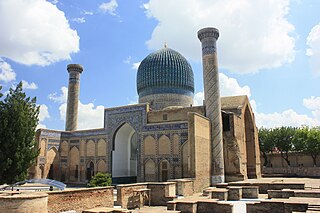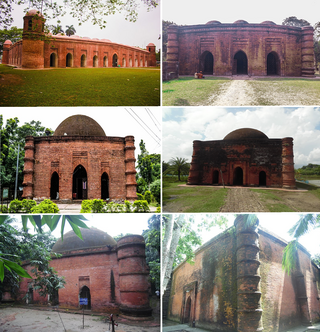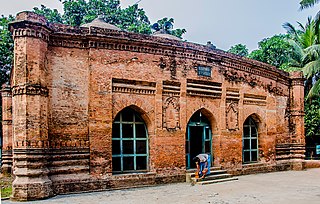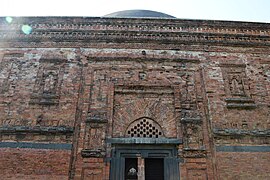
The Gūr-i Amīr or Guri Amir is a mausoleum of the Turco-Mongol conqueror Timur in Samarkand, Uzbekistan. It occupies an important place in the history of Central Asian architecture as the precursor for and had influence on later Mughal architecture tombs, including Gardens of Babur in Kabul, Humayun's Tomb in Delhi and the Taj Mahal in Agra, built by Timur's Indian descendants, Turco-Mongols that followed Indian culture with Central Asian influences. Mughals established the ruling Mughal dynasty of the Indian subcontinent. The mausoleum has been heavily restored over the course of its existence.

The Mosque City of Bagerhat is a UNESCO World Heritage Site in Bagerhat District, Bangladesh. It contains 360 mosques, public buildings, mausoleums, bridges, roads, water tanks and other public buildings constructed from baked brick. The mosques were built during the Bengal Sultanate in the 15th century, of which the Sixty Dome Mosque is the largest. Other mosques include the Singar Mosque, the Nine Dome Mosque, the Tomb of Khan Jahan, the Bibi Begni Mosque and the Ronvijoypur Mosque. The mosques were built during the governorship of Ulugh Khan Jahan, a Turkic military officer appointed as governor in the Sundarbans by Sultan Mahmud Shah of Bengal.

Gauḍa is a historic city of Bengal in the eastern part of the Indian subcontinent, and one of the most prominent capitals of classical and medieval India, being the capital city of Bengal under several kingdoms. The Gauḍa region was also a province of several pan-Indian empires. During the seventh century, the Gour Kingdom was founded by King Shashanka, whose reign corresponds with the beginning of the Bengali calendar. Gour gradually became synonymous with Bengal and Bengalis. It was conquered by Bakhtiyar Khalji, a lieutenant of the Ghurid ruler Muhammad of Ghori in 1203.

Indo-Islamic architecture is the architecture of the Indian subcontinent produced by and for Islamic patrons and purposes. Despite an initial Arab presence in Sindh, the development of Indo-Islamic architecture began in earnest with the establishment of Delhi as the capital of the Ghurid dynasty in 1193. Succeeding the Ghurids was the Delhi Sultanate, a series of Central Asian dynasties that consolidated much of North, East, and Central India, and later by the Mughal Empire during the early 16th century. Both of these dynasties introduced Islamic architecture and art styles from West Asia into the Indian subcontinent.

Pandua, also historically known as Hazrat Pandua and later Firuzabad, is a ruined city in the Malda district of the Indian state of West Bengal. It served as the capital city of the independent Sultanate of Bengal for nearly a century, until the capital was moved to nearby Lakhnauti in 1450.

Nāṣiruddīn Maḥmūd Shāh was the first Sultan of Bengal belonging to the restored Ilyas Shahi dynasty. Formerly a farmer, he was selected as the next ruler of Bengal by the erstwhile nobility in 1435 CE, and ruled the country for over twenty years. During his peaceful reign, Bengal saw significant architectural development.

The Architecture of Bengal, which comprises the modern country of Bangladesh and the Indian states of West Bengal, Tripura and Assam's Barak Valley, has a long and rich history, blending indigenous elements from the Indian subcontinent, with influences from different parts of the world. Bengali architecture includes ancient urban architecture, religious architecture, rural vernacular architecture, colonial townhouses and country houses and modern urban styles. The bungalow style is a notable architectural export of Bengal. The corner towers of Bengali religious buildings were replicated in medieval Southeast Asia. Bengali curved roofs, suitable for the very heavy rains, were adopted into a distinct local style of Indo-Islamic architecture, and used decoratively elsewhere in north India in Mughal architecture.

The Adina Mosque (N-WB-81) is a former mosque in Malda District, West Bengal, India. It was the largest structure of its kind in the Indian subcontinent and was built during the Bengal Sultanate as a royal mosque by Sikandar Shah, who is also buried inside. The mosque is situated in Pandua, a former royal capital.

Shamsuddin Ilyas Shah was the founder of the Sultanate of Bengal and its inaugural Ilyas Shahi dynasty. The Ilyas Shahi Dynasty ruled Bengal for 145 years (1342–1487), except for a 21-year interregnum by the descendants of Raja Ganesha. The Ilyas Shahi rulers are considered to be among the most important political, diplomatic and military leaders of Bengal during the sultanate period. In Bengali history, Ilyas Shah himself has been compared with Alexander the Great because of his ability to conquer large swathes of the Indian subcontinent. Ilyas Shah was instrumental in unifying the principalities of Bengal into a single state.

Jalaluddin Muhammad Shah was a 15th-century Sultan of Bengal and an important figure in medieval Bengali history. Born a Hindu to his aristocratic father Raja Ganesha, the patriarch of the Ganesha dynasty, he assumed the throne of Bengal after a coup which overthrew the Ilyas Shahi dynasty. He converted to Islam and ruled the Bengal Sultanate for 16 years. As a Muslim king, he brought Arakan under Bengali suzerainty and consolidated the kingdom's domestic administrative centres. He pursued relations with the Timurid Empire, Mamluk Egypt and Ming China. Bengal grew in wealth and population during his reign. He also combined Bengali and Islamic architecture.

Shamsuddīn Aḥmad Shāh was the last Sultan of Bengal belonging to the House of Ganesha. He was the son and successor of Sultan Jalaluddin Muhammad Shah. After his father's death, he ascended the throne at the age of 14.

The Bengal Sultanate was a late medieval sultanate based in the Bengal region between the 14th and 16th century. It was the dominant power of the Ganges-Brahmaputra Delta, with a network of mint towns spread across the region. The Bengal Sultanate had a circle of vassal states in the Indian subcontinent, including parts of Odisha in the southwest, Arakan in the southeast, and Tripura in the east.

The Singar Mosque is a 15th-century mosque that forms a part of the Mosque City of Bagerhat, a designated World Heritage Site in the southwestern region of Bangladesh. This mosque is characterized by its single-domed, square structure constructed with exposed brick and adorned with terracotta decorations.

Darasbari Mosque is a historic mosque that was built in 1479 AD.

Baba Adam's Mosque is a mosque situated in the village of Qadi Qasbah under Rampal Union of Bangladesh's Munshiganj District. It was constructed in 1483 A.D by Malik Kafur to function as a Jami mosque during the reign of Jalaluddin Fateh Shah. The tomb of Baba Adam Shahid, a 15th-century Muslim preacher, lies near the edifice.

The Goaldi Mosque is a mosque in the historic Bengali capital of Sonargaon. It was built during the Bengal Sultanate under the reign of Sultan Alauddin Hussain Shah. It is one of the few surviving medieval monuments in Sonargaon Upazila, Bangladesh.

Bengali Muslims are adherents of Islam who ethnically, linguistically and genealogically identify as Bengalis. Comprising about two-thirds of the global Bengali population, they are the second-largest ethnic group among Muslims after Arabs. Bengali Muslims make up the majority of Bangladesh's citizens, and are the largest minority in the Indian states of West Bengal, Tripura and Assam.
The House of Ganesha was the second royal house of the late medieval Sultanate of Bengal. It is named after its founder Raja Ganesha, a wealthy Hindu nobleman, who succeeded the former Ilyas Shahi dynasty. His son embraced Islam and ruled as Jalaluddin Muhammad Shah, and was succeeded by his son Shamsuddin Ahmad Shah.
Faqir Mosque is an oblong six-domed Islamic place of worship in Bangladesh's Chittagong District. The fifteenth-century mosque dates back to the Bengal Sultanate period.

Nūr Qut̤b ʿĀlam was a 14th-century Bengali Islamic scholar, author and poet. Based in the erstwhile Bengali capital Hazrat Pandua, he was the son and successor of Alaul Haq, a senior scholar of the Bengal Sultanate. He is noted for his efforts in preserving the Muslim rule of Bengal against Raja Ganesha and pioneering the Dobhashi tradition of Bengali literature.




















